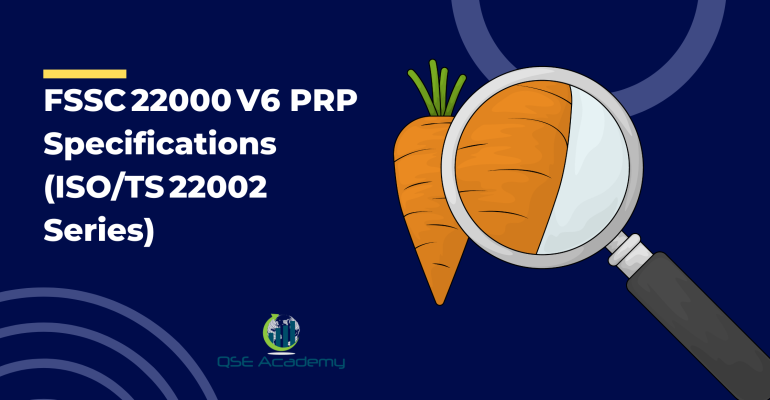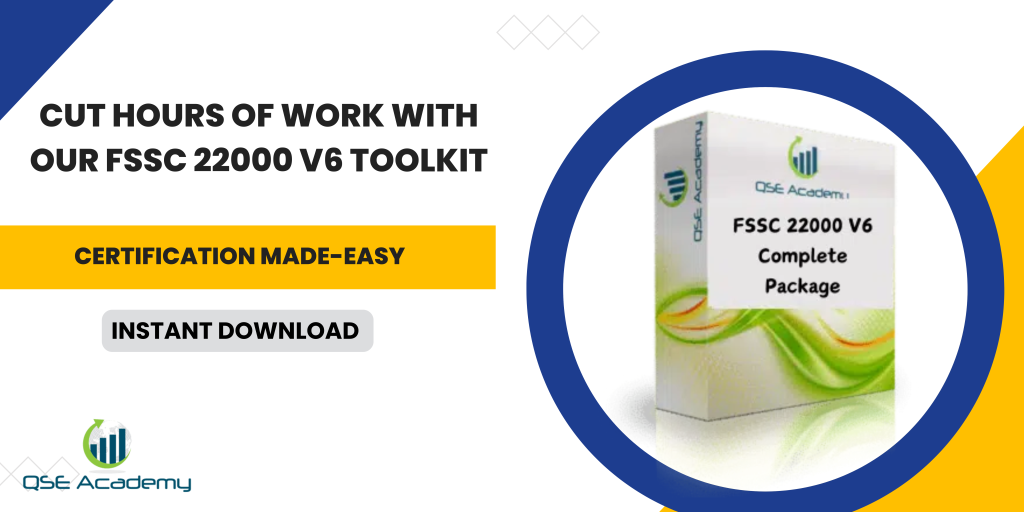FSSC 22000 V6 PRP Specifications (ISO/TS 22002 Series)
Why PRPs Are the Unsung Heroes of FSSC 22000 V6
When most companies start implementing FSSC 22000 V6, they focus on HACCP or risk assessments. But here’s what I’ve seen again and again: the real audit trouble comes from weak Prerequisite Programs (PRPs).
At QSE Academy, we’ve helped food manufacturers, caterers, and packaging plants pass FSSC 22000 audits across every continent. And one pattern stands out — those who invest time building solid PRPs under the ISO/TS 22002 series almost always pass on the first try.
This guide breaks down what PRPs are, how each ISO/TS 22002 specification works, and how you can implement them effectively for your sector.
Understanding PRPs in the Context of FSSC 22000 V6
Think of PRPs as your factory’s immune system — they keep contamination, cross-contact, and hygiene failures under control before anything reaches HACCP level.
PRPs form the foundation of ISO 22000:2018 Clause 8 (Operation) and are mandatory under FSSC 22000 V6 Part 2. They cover everything from building layout to cleaning schedules, pest control, and personnel hygiene.
In simple terms, HACCP prevents problems, but PRPs prevent chaos.
You can’t have one without the other.
Pro Tip: Always establish strong PRPs first. Once they’re working smoothly, your HACCP plan becomes easier to maintain and audit.
Common Mistake: Treating PRPs as “extra paperwork.” Auditors expect them to be active, monitored, and validated daily — not stored in a binder.
 The ISO/TS 22002 Series — Sector-Specific PRP Specifications
The ISO/TS 22002 Series — Sector-Specific PRP Specifications
Not all food sectors share the same hygiene challenges. That’s why the ISO/TS 22002 series provides sector-specific PRP standards. Here’s how to know which one applies to you:
| ISO/TS Standard | Sector/Application | Key Focus Areas |
|---|---|---|
| ISO/TS 22002-1 | Food Manufacturing | Facility layout, cleaning, pest control, utilities, waste handling, personnel hygiene |
| ISO/TS 22002-2 | Catering | Kitchen hygiene, temperature control, food prep zones, sanitation frequency |
| ISO/TS 22002-3 | Farming | Feed, water safety, animal health, veterinary controls, harvesting hygiene |
| ISO/TS 22002-4 | Packaging Manufacturing | Product design, contamination prevention, traceability, material compatibility |
| ISO/TS 22002-5 | Transport & Storage | Temperature mapping, segregation, vehicle hygiene, loading protocols |
| ISO/TS 22002-6 | Feed Production | Ingredient sourcing, contamination control, cleaning verification |
| PAS 221 / PAS 223 | Retail / Packaging Alternatives | Custom PRPs for niche sectors or hybrid operations |
Pro Tip: Always match your PRP standard to your FSSC 22000 category code.
Example: One of our beverage clients used ISO/TS 22002-1 (food manufacturing) instead of 22002-4 (packaging). They failed their first audit due to missing design-control requirements. Realigning to the correct PRP standard cleared all major nonconformities.
Mapping PRPs to ISO 22000 Clauses and FSSC V6 Requirements
PRPs don’t exist in isolation — they support ISO 22000 Clauses 8.2 to 8.5 and directly tie into FSSC 22000 V6’s Additional Requirements.
Here’s how the mapping typically looks:
| PRP Area | ISO 22000 Reference | FSSC V6 Addition |
|---|---|---|
| Cleaning & Sanitation | 8.5.1 | 2.5.3 Cleaning Program |
| Personnel Hygiene | 7.2 & 8.2 | 2.5.5 Training & Awareness |
| Pest Control | 8.5.1 | 2.5.2 Hygiene Control |
| Allergen Control | 8.5.2 | 2.5.6 Allergen Management |
| Equipment Maintenance | 8.5.1 | 2.5.7 Preventive Maintenance |
Pro Tip: Create a “PRP–Clause Mapping Table.” It’s one of the easiest ways to prove compliance during an audit.
Common Mistake: Listing every cleaning or inspection step as a CCP. Remember, PRPs control general conditions; CCPs handle critical hazards. Mixing them up only confuses your team and your auditor.
Implementing PRPs Effectively — Documentation, Monitoring & Validation
Strong PRPs live and breathe through good documentation.
Start with clear procedures, then back them up with daily checklists and verification logs.
For example, in one snack-food factory we assisted, operators used a laminated cleaning checklist beside every workstation. Supervisors signed off twice a shift. That simple habit cut audit nonconformities by 70%.
Pro Tip: Keep PRP forms short and visual — photos, icons, or bilingual labels work better than text-heavy pages.
Validation Example: Use ATP testing or micro-swab results to prove your cleaning program actually works.
Common Pitfall: Having beautiful PRP procedures but no monitoring records. In audits, “no record” means “didn’t happen.”
Integrating PRPs with Food Defense, Food Fraud, and Allergen Control
FSSC 22000 V6 expanded the PRP concept to include Food Defense, Food Fraud Prevention, and Allergen Management.
Think of these as advanced PRPs — they rely on the same foundations but focus on intentional or hidden risks.
- Food Defense: Secure access points, control visitor flow, and monitor deliveries.
- Food Fraud: Verify suppliers, control raw-material authenticity, monitor ingredient substitution risks.
- Allergen Control: Combine labeling checks, dedicated tools, and validated cleaning methods.
Pro Tip: Combine overlapping controls in one integrated matrix. It reduces duplication and saves time during audits.
Real Example: A confectionery plant we guided embedded allergen segregation in their cleaning PRP. They passed their FSSC audit with zero allergen-related findings and cut recordkeeping time by one-third.
Verification & Continuous Improvement of PRPs
PRPs aren’t “set and forget.” They evolve with every new product, supplier, or layout change.
Clause 9 of ISO 22000 reminds us to monitor performance and drive improvement — and PRPs are no exception.
Use internal audits, visual inspections, and KPI tracking to verify effectiveness.
Metrics like pest sightings, sanitation deviations, or temperature excursions tell you where to focus.
Pro Tip: Review PRP data in management reviews — not just HACCP deviations. It shows leadership engagement and system maturity.
Common Mistake: Keeping PRPs static. Every facility expansion, new packaging line, or supplier change means your PRPs must be re-evaluated.
FAQs — Common PRP Questions in FSSC 22000 V6 Audits
Q1: Do I need to implement all ISO/TS 22002 standards?
No. Use the one that fits your category under FSSC 22000 (e.g., 22002-1 for food manufacturing, 22002-4 for packaging).
Q2: How often should PRPs be reviewed?
At least once a year — or whenever major process, facility, or product changes occur.
Q3: Can I merge multiple PRP standards if my operations overlap?
Yes, hybrid facilities can combine relevant sections. Just keep roles, monitoring, and responsibilities clearly defined.
Conclusion — Strong PRPs, Strong FSMS
PRPs are the quiet workhorses of every food safety system. When done right, they prevent problems long before they reach your CCPs.
The ISO/TS 22002 series gives you the structure; FSSC 22000 V6 gives you global credibility. Together, they create a system that not only passes audits — it protects your brand.
At QSE Academy, we’ve helped countless teams turn PRP chaos into clean, auditable control.
If you’re ready to tighten your hygiene programs and simplify documentation:
Download QSE Academy’s FSSC 22000 V6 PRP Implementation Toolkit
or
Book a Free Consultation with our team to assess your PRP readiness.
Melissa Lavaro is a seasoned ISO consultant and an enthusiastic advocate for quality management standards. With a rich experience in conducting audits and providing consultancy services, Melissa specializes in helping organizations implement and adapt to ISO standards. Her passion for quality management is evident in her hands-on approach and deep understanding of the regulatory frameworks. Melissa’s expertise and energetic commitment make her a sought-after consultant, dedicated to elevating organizational compliance and performance through practical, insightful guidance.








